Should have decent heat resistance too, since they are intended for frying meat on.Thin - like a sheet of thick paper. But they're teflon (PTFE) coated which kills two birds with one stone - no rubbing, and very electrically insulating.
You are using an out of date browser. It may not display this or other websites correctly.
You should upgrade or use an alternative browser.
You should upgrade or use an alternative browser.
Last fire.. :-(
- Thread starter Frank in Thailand
- Start date
Yep. I use these in my Outback Australia deployments (you can see one of my stories here - https://community.ui.com/stories/Di...Unstuck-/2f261189-0ef4-4fa1-a7e1-d5a78373af46). I've been using Frey batteries for the last 2 years, with these BBQ sheets as dividers, in one of the hottest places in the country.Should have decent heat resistance too, since they are intended for frying meat on.
No problems to report.. I am, however, going to need to do a heck load of testing on these EVE batteries before I even consider deploying them given a few of these horror stories.. suspect the difference in weight and tendency to swell for the Eve's vs the Frey's I've been using may be largely due to less exacting build quality. Concerning.
PTFE is an AMAZING molecule. It can be used for all types of things.Leon - more about ptfe sheeting here. https://polyfluoroltd.com/blog/ptfe-battery-separators-an-essential-insulating-media/
Personally, I try stay away from it though (I do still use PTFE thread tape, nothing comes close). The byproducts of manufacturing turned a whole state into the butt of "inbred" jokes, and poisoned the Chesapeake Bay. ? The byproducts were so bad that not even Nazis wanted to make the stuff.
That article is just the tip of the iceberg, C8 is horrid stuff. "The Devil We Know" on Netflix is great if anyone wants the low-down.
IMHO, silicone variants and varieties will take teflon's place before too long.
Observando detenidamente la construcción de la batería he observado dos posibles causas potenciales de incendio:
1. Variila de comprensión de celdas sin aislamiento !!
2. Las celdas no tienen separadores aislantes !!
Esto puede provocar un cortocircuito entre celdas. Es el 2 ° incendio que tienes, la ley de Murphy por el doble incendio o un método de construcción no seguro?
---------------------------------------
Looking closely at the construction of the battery I have observed two possible potential causes of fire:
1. Variila of compression of cells without isolation !!
2. The cells do not have insulating spacers !!
This can cause a short circuit between cells. Is it the 2nd fire you have, Murphy's law for the double fire or an unsafe construction method?
1. Variila de comprensión de celdas sin aislamiento !!
2. Las celdas no tienen separadores aislantes !!
Esto puede provocar un cortocircuito entre celdas. Es el 2 ° incendio que tienes, la ley de Murphy por el doble incendio o un método de construcción no seguro?
---------------------------------------
Looking closely at the construction of the battery I have observed two possible potential causes of fire:
1. Variila of compression of cells without isolation !!
2. The cells do not have insulating spacers !!
This can cause a short circuit between cells. Is it the 2nd fire you have, Murphy's law for the double fire or an unsafe construction method?
Ok… 12 pages in, and a repeat guess… please read a bit before tossing in opinions. There is a lot going on in his build. Maybe we need a poll on this video, so those not willing to dive into a 12 page thread don’t keep repeating guesses?Observando detenidamente la construcción de la batería he observado dos posibles causas potenciales de incendio:
1. Variila de comprensión de celdas sin aislamiento !!
2. Las celdas no tienen separadores aislantes !!
Esto puede provocar un cortocircuito entre celdas. Es el 2 ° incendio que tienes, la ley de Murphy por el doble incendio o un método de construcción no seguro?
---------------------------------------
Looking closely at the construction of the battery I have observed two possible potential causes of fire:
1. Variila of compression of cells without isolation !!
2. The cells do not have insulating spacers !!
This can cause a short circuit between cells. Is it the 2nd fire you have, Murphy's law for the double fire or an unsafe construction method?
400bird
Solar Wizard
I don't think we need destructive testing. But, I'd watch the video!
Just measure voltage between an exposed part of the aluminum case and each battery terminal.
If you have voltage, that's a current path waiting to be found.
Those old calb, Winston, and other cells were all coated in thick plastic. These EVE cells only have the thinnest layer of insulation. If you get a nick that lines up on two opposing cells, you're just created a short. Or if you threaded rod isn't insulated and rubs on two cells further apart.
My understanding is that there may be some resistance between the terminals and case, so it's possibly not an immediate dead short, but given some time and bad luck...
Just measure voltage between an exposed part of the aluminum case and each battery terminal.
If you have voltage, that's a current path waiting to be found.
Those old calb, Winston, and other cells were all coated in thick plastic. These EVE cells only have the thinnest layer of insulation. If you get a nick that lines up on two opposing cells, you're just created a short. Or if you threaded rod isn't insulated and rubs on two cells further apart.
My understanding is that there may be some resistance between the terminals and case, so it's possibly not an immediate dead short, but given some time and bad luck...
I think we do. From what I have seen, even dramatic over charge or discharge doesn't cause a fire.I don't think we need destructive testing. But, I'd watch the video!
Just measure voltage between an exposed part of the aluminum case and each battery terminal.
If you have voltage, that's a current path waiting to be found.
Those old calb, Winston, and other cells were all coated in thick plastic. These EVE cells only have the thinnest layer of insulation. If you get a nick that lines up on two opposing cells, you're just created a short. Or if you threaded rod isn't insulated and rubs on two cells further apart.
My understanding is that there may be some resistance between the terminals and case, so it's possibly not an immediate dead short, but given some time and bad luck...
High current lab's video is the only one I have seen with actual fire. And that's closer to a car crash than a battery sitting in the basement hooked up wrong.
What causes a fire and what just destroys the battery? I don't think we really know right now.
I'm not sure if I posted this in this thread or somewhere else, but on last year's EVE 280Ah (version E I think) cells I shorted terminals to the case with no effect. There is a voltage between negative terminal and case, but only leakage current.

 diysolarforum.com
diysolarforum.com
This might be different for new/different cells.

Heltec BMS' (up to 350A) with Active Balancing & Independent Active Balancers
Maybe check with a light bulb and see if it is just a tiny leakage current, or if it can actually pull current to the case. Some meters are very sensitive and a tiny bit of moisture can carry enough current to show full voltage. But if it won't light a small bulb, it is likely not a concern in...
This might be different for new/different cells.
I'm not sure if I posted this in this thread or somewhere else, but on last year's EVE 280Ah (version E I think) cells I shorted terminals to the case with no effect. There is a voltage between negative terminal and case, but only leakage current.

Heltec BMS' (up to 350A) with Active Balancing & Independent Active Balancers
Maybe check with a light bulb and see if it is just a tiny leakage current, or if it can actually pull current to the case. Some meters are very sensitive and a tiny bit of moisture can carry enough current to show full voltage. But if it won't light a small bulb, it is likely not a concern in...diysolarforum.com
This might be different for new/different cells.
Thanks for the info! I have 16 EVE cells to make a 2p4s battery. Being a concern to properly isolate the cells from all contact. I will continue with the project of isolating them anyway but it reassures me that the possibility of a short is not high.
-----------------------
Gracias por la información! Yo tengo 16 celdas EVE para hacer una batería 2p4s. Siendo una preocupación el aislar debidamente las celdas de todo contacto. Seguiré con el proyecto de aislarlas igualmente pero me tranquiliza que la posibilidad de corto no sea alta.
OP mentioned having to drill and tap posts on several cells although I don't know if he has the records to confirm whether this particular cell was repaired. Apparently, one of the models of cells he had was discontinued and apparently has questionable reliability.To me the area surrounding the terminal in the photo in the first post looks like a case of metal stress fatigue. I can posit that at some stage during freight or manufacture or post-manufacture that stud has copped a hard hit. That, alongside a slow bending moment potentially from expansion and contraction of the bank has lead that microscopic weak point to grow until it's eventually failed catastrophically and then you've got your conflagration.
Nonetheless, these posts are freaking me out as I have just bought some EVE cells and plan to put them in a hot, bushfire prone area. I've used other brands successfully for a long time in similar circumstances but you can bet I'm going to do a lot more research on these cells.
I'm going to be probably use something like an old metal filing cabinet with mineral wool placed on a concrete floor in a brick-out building, not in an attached garage.
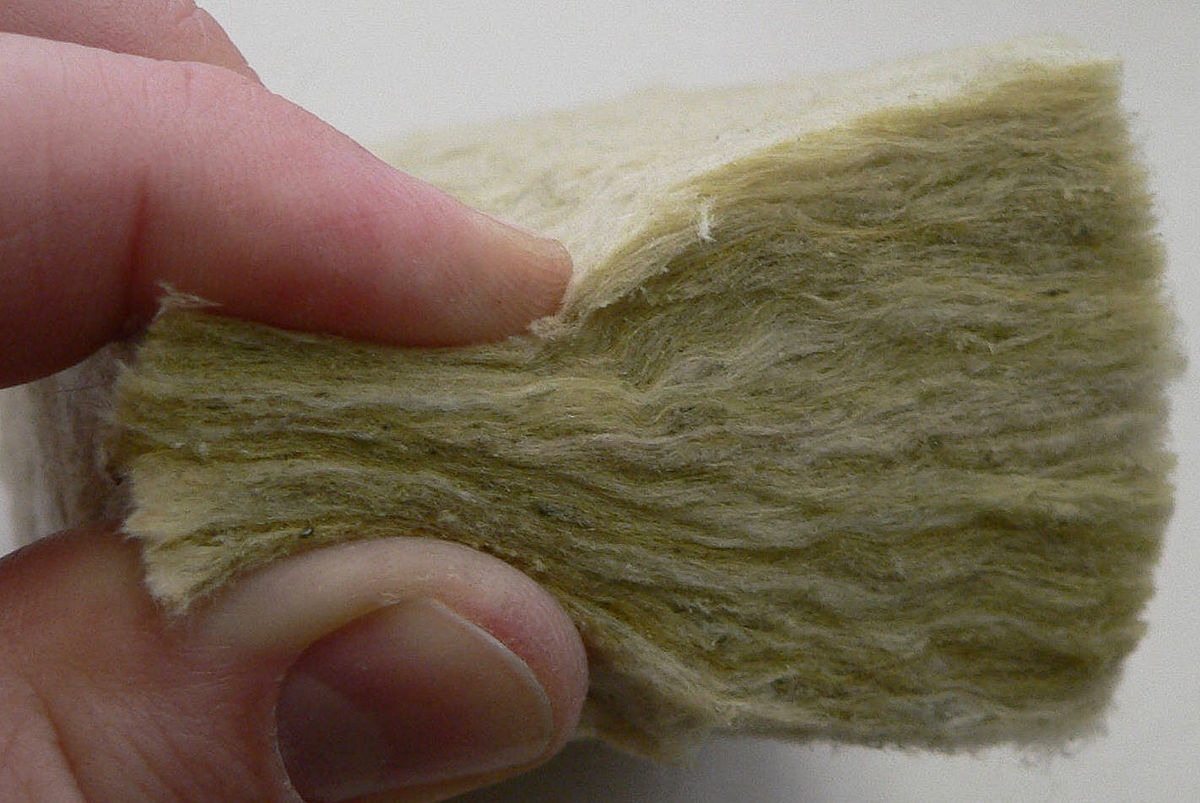
Mineral wool - Wikipedia
Mineral Wool Insulation - Insulation - The Home Depot
Get free shipping on qualified Mineral Wool Insulation products or Buy Online Pick Up in Store today in the Building Materials Department.
www.homedepot.com
So I'm mainly concerned with how to allow compression with cycling but also provide some level of electrical and heat insulation between cells. I'm leaning toward Hardy board between cells as another relatively cheap material.
https://www.homedepot.com/p/James-H...x-0-42-in-Cement-Backerboard-220023/100170507
I'm looking at a 32 cell 16S2P configuration oriented such that their bulging/compression forces are perpendicular to the busbars. Alternatively, I would go with all flexible cables.
I think these types of situations where a cells shorts are rare but they do occur and in that event you want to have a design (string level BMS and breakers) that does not cascade into as you say "conflagration". The hope is to contain the damage to the internal short of a single cell where there is little you can do beyond insulating/isolating that particular cell.
Frank in Thailand
making mistakes so you don't have to...
Some additional information:
yes, the cell that was most likely the one that started the mess, I did renew the thread to M8.
No, I did not make pictures removing the sand, and the disassemble process.
Parallel in the same set seems logical, easy even. You need just one BMS for 2 x 16 cells.
It also increases the complexity a lot.
if you have one strange reading, 2 cells might be the reason, 4 terminals.
Without torque meter, you will mismatch the compression of the busbar on the terminal.
Assuming you absolutely cleaned the aluminum and copper from all oxidation, and mounted the busbar on the aluminum within 20 seconds.
longer time the oxidation of the aluminum will give different readings. a few seconds wont matter that much, minutes will.
for 2P its easy, you just need 4 busbars to make the parallel and series contact, double busbars..

3P gets nasty, you'll end up with 3 layer...
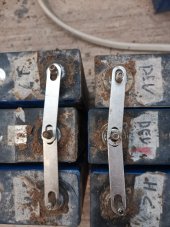
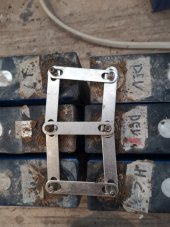
some will say this is the way it should be:

I disagree. distance between the sets is uneven per cell, what will give imbalance in the set.
it does "automatically" correct itself, as it's a parallel set, that is it, it does get imbalance and does correct, where the 8 shape keeps load and balance the same.
either way...
a misreading is harder to find.
and if you have one thread getting loose, ripped out, you need to unscrew a lot of cells.
reconnecting, fastening the nuts, some that held the first time will now fail.
and the dance goes round and round.... until I ended up with 39 threads to repair.
Due to this error, I stopped the "traditional parallel" 5 strings of 16 cells in series, each would need its own BMS.
This is how the busbars where mounted before the tragic accident.
Not like these pictures, I've tried and failed due failing aluminum threads.
2 x S16 had busbars.
One set of 8 (half of 16) had busbars.
The rest nothing yet.
I told I'll post schematics, but I totally s*ck at drawing.
I'll do my best
yes, the cell that was most likely the one that started the mess, I did renew the thread to M8.
No, I did not make pictures removing the sand, and the disassemble process.
Parallel in the same set seems logical, easy even. You need just one BMS for 2 x 16 cells.
It also increases the complexity a lot.
if you have one strange reading, 2 cells might be the reason, 4 terminals.
Without torque meter, you will mismatch the compression of the busbar on the terminal.
Assuming you absolutely cleaned the aluminum and copper from all oxidation, and mounted the busbar on the aluminum within 20 seconds.
longer time the oxidation of the aluminum will give different readings. a few seconds wont matter that much, minutes will.
for 2P its easy, you just need 4 busbars to make the parallel and series contact, double busbars..

3P gets nasty, you'll end up with 3 layer...


some will say this is the way it should be:

I disagree. distance between the sets is uneven per cell, what will give imbalance in the set.
it does "automatically" correct itself, as it's a parallel set, that is it, it does get imbalance and does correct, where the 8 shape keeps load and balance the same.
either way...
a misreading is harder to find.
and if you have one thread getting loose, ripped out, you need to unscrew a lot of cells.
reconnecting, fastening the nuts, some that held the first time will now fail.
and the dance goes round and round.... until I ended up with 39 threads to repair.
Due to this error, I stopped the "traditional parallel" 5 strings of 16 cells in series, each would need its own BMS.
This is how the busbars where mounted before the tragic accident.
Not like these pictures, I've tried and failed due failing aluminum threads.
2 x S16 had busbars.
One set of 8 (half of 16) had busbars.
The rest nothing yet.
I told I'll post schematics, but I totally s*ck at drawing.
I'll do my best
Last edited:
Frank in Thailand
making mistakes so you don't have to...
My 3 inverters in parallel.
Each have own solar panel group (front of the house, side and in the green house)
Each able to quickly stop with Contactor.
They connect to backbone bus-bar.
That has contactor between the battery.

I hope that makes sense.
The batteries, both layers the same, zigzag.
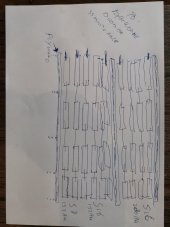
Plywood had between the cells 3 X threaded rods, that made the clamping force.
15* threaded rods.
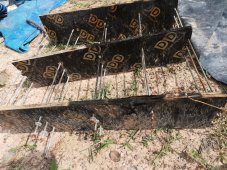
Current setup:
2* 3.2kw untits in parallel.
One 5.5 KW unit that is replacement for the defective one.
(Was 3.2kw)

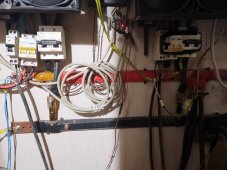
Bus-bars backbone, and each unit have breakers for the AC, DC Solar (350v) and DC battery.
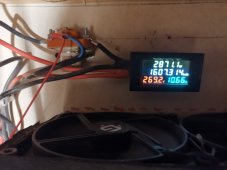
50A Contactor and additional AM meter.
And the 400A Contactor for the battery.
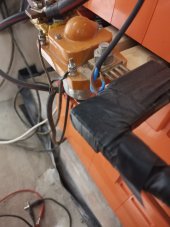
I modified the in and out of the airflow.
Units are now almost silent even with 4500 Watt solar and 3000 watt load.
Not cheap, Silent Wings 3 120mm high speed fans are just about the only Fans that create enough static air pressure and stay silent.
Top ones controlled by the Inverter, bottom ones separate 12v supply.
Liquid bearing, last about 30 years on full speed.
Probably 2 at the top or bottom are enough.
I've lost in the past a few inverted (Giadefender 6000w) due crap thermal management and failing fans, I don't take risks on that field anymore.
It's a $100 bucks per inverter well spend.
And the fans do really last a lifetime.
I have some noctua, 11 years old, just as Silent as the first day, nice
Just bad that they have crap static air pressure, not enough airflow for an inverter.
That a fan with liquid bearing can run a long, long time...
11 years and counting
I doubt the inverters will live that long.
Each have own solar panel group (front of the house, side and in the green house)
Each able to quickly stop with Contactor.
They connect to backbone bus-bar.
That has contactor between the battery.

I hope that makes sense.
The batteries, both layers the same, zigzag.

Plywood had between the cells 3 X threaded rods, that made the clamping force.
15* threaded rods.

Current setup:
2* 3.2kw untits in parallel.
One 5.5 KW unit that is replacement for the defective one.
(Was 3.2kw)


Bus-bars backbone, and each unit have breakers for the AC, DC Solar (350v) and DC battery.

50A Contactor and additional AM meter.
And the 400A Contactor for the battery.

I modified the in and out of the airflow.
Units are now almost silent even with 4500 Watt solar and 3000 watt load.
Not cheap, Silent Wings 3 120mm high speed fans are just about the only Fans that create enough static air pressure and stay silent.
Top ones controlled by the Inverter, bottom ones separate 12v supply.
Liquid bearing, last about 30 years on full speed.
Probably 2 at the top or bottom are enough.
I've lost in the past a few inverted (Giadefender 6000w) due crap thermal management and failing fans, I don't take risks on that field anymore.
It's a $100 bucks per inverter well spend.
And the fans do really last a lifetime.
I have some noctua, 11 years old, just as Silent as the first day, nice
Just bad that they have crap static air pressure, not enough airflow for an inverter.
That a fan with liquid bearing can run a long, long time...
11 years and counting
I doubt the inverters will live that long.
Those circuit breakers need some DIN rail behind them.
Frank in Thailand
making mistakes so you don't have to...
left one has.Those circuit breakers need some DIN rail behind them.
Other 2 still need.
They got "lost" during construction but are found again.
Where it does make it look more neat, it doesn't make it more safe.
Next week...
when I'm going to tidy the wires even more.
The parallel cables are long, not easy to make clean looking.
and yes, the middle one have carton as fan housing.. the hard foam was bought in BKK, BTS shop.
2 different online orders where totally different and useless for this purpose materials.
Till I'm back in BKK to buy the same rigid foam to make nice shape, carton is a really good temporal solution
Yes, it does. You have breakers hanging from the wiring, you can't possibly think that that is just as safe as properly mounted DIN rails. Heat from your loads will slowly expand and contract the wiring, and loosen your connections over time, if the breakers were properly mounted, and one of the wires came loose or fell out, the breaker stays there; If your wire falls out, that breaker (or wire) could short something else as it falls.Where it does make it look more neat, it doesn't make it more safe.
Just like before, I'm not claiming to know why your fire started, and I'm certainly not saying it was those breakers. But you need to be aware that this forum has a metric s*itload of viewers who take the advice they see here and use it. Telling people that unmounted breakers are just as safe as mounted ones is somewhat irresponsible.
left one has.
Other 2 still need.
They got "lost" during construction but are found again.
Where it does make it look more neat, it doesn't make it more safe.
That's BS. A circuit breaker hanging by the wires puts stress on the connection.
As a foreman supervising a crew of electricians, there was one electrican who always produced sloppy work, whenever I confronted him regarding the quality of his craftsmanship, his answer was "is it electrically safe?" My answer was perhaps, but rip it all out and start again, because it doesn't meet my standards, unfortunately he was incapable of ever meeting my standards.
My journeyman "supervisor", when I was an apprentice, said that the neatness of the finished product is a reflection of the overall quality of the installation, taking pride in one's work is important, needless to say I had to redo installations until I met his standards.
Unfortunately many do not have excellent formal electrical training, as such don't understand the importance of neatness , but may possess skills in their craft, whatever it may be, where they may question the quality of others who do not have their abilities or professional aptitude, so it's unfair to judge, but conversely it's important to accept constructive criticism and in this case it's warranted...it's a mess, even to the untrained eye.
My journeyman "supervisor", when I was an apprentice, said that the neatness of the finished product is a reflection of the overall quality of the installation, taking pride in one's work is important, needless to say I had to redo installations until I met his standards.
Unfortunately many do not have excellent formal electrical training, as such don't understand the importance of neatness , but may possess skills in their craft, whatever it may be, where they may question the quality of others who do not have their abilities or professional aptitude, so it's unfair to judge, but conversely it's important to accept constructive criticism and in this case it's warranted...it's a mess, even to the untrained eye.
Last edited:
Frank in Thailand
making mistakes so you don't have to...
Yes, it does. You have breakers hanging from the wiring, you can't possibly think that that is just as safe as properly mounted DIN rails. Heat from your loads will slowly expand and contract the wiring, and loosen your connections over time, if the breakers were properly mounted, and one of the wires came loose or fell out, the breaker stays there; If your wire falls out, that breaker (or wire) could short something else as it falls.
Just like before, I'm not claiming to know why your fire started, and I'm certainly not saying it was those breakers. But you need to be aware that this forum has a metric s*itload of viewers who take the advice they see here and use it. Telling people that unmounted breakers are just as safe as mounted ones is somewhat irresponsible.
You are correct.
The main DC breaker is not going anywhere, stuck between 4* 35mm2 copper wires, short who are mounted on the bus-bar that also aren't going anywhere as being massive copper.
I can hang on it, if I want to, and it won't get lose.
That is in my situation.
Not most readers at home.
Also, the wires aren't hanging on the breakers, they are clamped on the wall with clips.
I can untighten all the screws and the breakers won't move (a lot) won't fall down.
The wires won't slip out of their mounting holes as there are kept in place being stuck to the wall.
In MY installation the breakers are "floating" between the wires.
People who expect hanging wires pulling down, probably talk about their own setup that needs improvement
For me the only difference is neat alignment of the breakers and remove of the tape.
No stress from hanging or pulling.
If that is your setup, no matter rail or not, you have a serious problem.
No wire should hang on any breaker.
It should be floating between the 2 ends, without any stress.
Surprised to see al this negativity!!
Am I'm the only one who finds this normal way of installing?
No stress in contact points of wires???
Apparently.
Really surprised to see this.
Frank in Thailand
making mistakes so you don't have to...
Lol.As a foreman supervising a crew of electricians, there was one electrican who always produced sloppy work, whenever I confronted him regarding the quality of his craftsmanship, his answer was "is it electrically safe?" My answer was perhaps, but rip it all out and start again, because it doesn't meet my standards, unfortunately he was incapable of ever meeting my standards.
My journeyman "supervisor", when I was an apprentice, said that the neatness of the finished product is a reflection of the overall quality of the installation, taking pride in one's work is important, needless to say I had to redo installations until I met his standards.
Unfortunately many do not have excellent formal electrical training, as such don't understand the importance of neatness , but may possess skills in their craft, whatever it may be, where they may question the quality of others who do not have their abilities or professional aptitude, so it's unfair to judge, but conversely it's important to accept constructive criticism and in this case it's warranted...it's a mess, even to the untrained eye.
Some see a mess where others see art
I know it's your job to criticise.
And sure, with unlimited funds and access to products, I could do it all again, a lot more nice.
You clearly don't live in Thailand, and absolutely not in a rural area.
If it's normal to have one shop sell stainless M6 nuts but not bolts, and the other shop might just have the bolts.. not the 50 you need, but 10.
Other shop has also.. too short, or way too long.
This is just M6 nuts and bolt.
In a country where safe is 2 wires twisted for lights in a gouvernement building, you will have a few years struggle to find the equipment you like to use.
Probably even end up buying a lot of it overseas.
Where transport and tax for a $10 tube of glue is $160,- (no joke, Amazon) you will need endless funds and time to make the installation as nice as you like.
Art.
It's amazing it's this neat and safe to build in rural Thailand.
Don't think it's here any better then the middle of Africa..
Your nice tools and stuff... Just isn't here.
You are welcome to ship it to me.
And I will install it.
As you like.
Alternative?
No electricity.
You know how that is?
A few people in Texas now have experience, for a really short time.
For us, 24/7, always.
Easy to bash when you have all tools and equipment available.
This is the best available.
And I didn't went cheap, at all.
Like the Dutch say: you can't brake iron with your bare hands, or for you English people, can't bent space and time.
I see art and am absolutely happy with the highest quality result capable with the limit equipment.
Similar threads
- Replies
- 235
- Views
- 10K
- Replies
- 4
- Views
- 204
- Replies
- 23
- Views
- 825
- Replies
- 1
- Views
- 124


